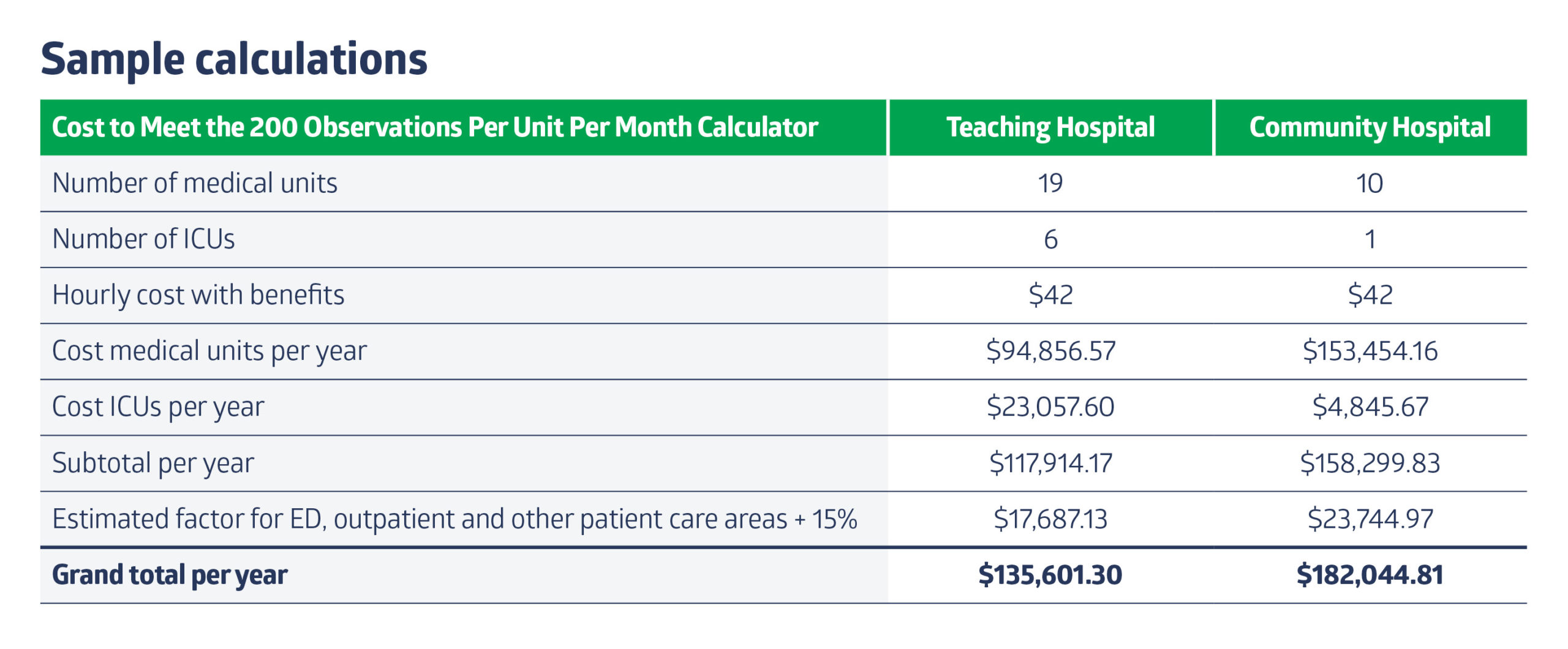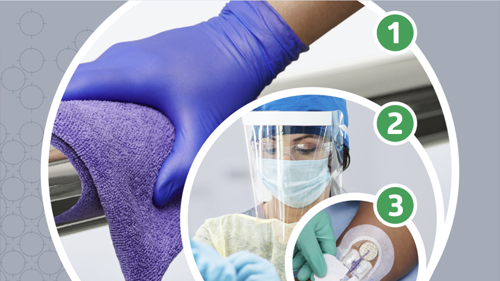What’s the budget for 200 direct observations of hand hygiene?
Learn 8 steps to calculate the monthly cost of 200 direct observations.

Many healthcare organizations are trying to calculate the real costs of hand hygiene direct observation to meet The Leapfrog Group standard of:
- 200 direct observations per unit per month for inpatient units
- Up to 200 observations per month for emergency department units, based on number of visits per month
- Up to 200 observations per unit per month for areas where the monthly occupancy rate fluctuates1 (e.g., PACU, outpatient units)
Fortunately, an evidence-based calculation for the true cost of those 2,400 visual observations per unit per year, based on the HOW2 (Hand Hygiene Opportunities Where and When) Benchmark Study,2 was published in American Journal of Infection Control in 2011.
The study’s purpose was to determine, for the first time, hand hygiene opportunities (HHOs) in two types of hospitals—teaching and community within three clinical areas: medical-surgical units, intensive care units (ICUs) and emergency departments (EDs). The study used trained direct observers, controlled for inter-rater reliability, to calculate the actual number of HHOs per patient day.
Calculations for each hospital
This column focuses on calculating the costs for inpatient areas. Outpatient and ED care is variable, so we’ll use a conservative plus-up factor estimate of 15% for these areas. However, the data is there to do exact calculations based on your organization’s actual statistics.
The HOW2 study determined the number of HHOs in adult medical units and ICUs (Table 1). Note that the study looked for WHO 5 Moment total HHOs3 but also broke down the data by moment, so we can calculate that “In and Out” HHOs in an adult medical unit equals 48.9 percent of the total.
From here, we just need to know the:
- True fully loaded cost for the staff doing the observations
- Total number of units and average bed counts for each
Then we can calculate the cost per year of meeting the 200 visual observations per unit per month.
The following calculations are based on two real hospitals: a teaching hospital and a community hospital. The bed counts and labor costs were provided by senior nursing leadership. The calculations were done based on the “in and out” standard for measuring hand hygiene, as most hospitals are unable to conduct accurate visual observations for the WHO 5 Moments.

Teaching hospital costs
There are 328 medical unit beds in 19 units, with an average of 17.3 beds per medical unit. There are also 54 ICU beds in six units, with an average of nine beds per ICU. The average cost for their nursing staff direct observers is $42 per hour with benefits.
Here is the calculation, which you can easily re-create for your organization:
Medical units
Step 1: Divide the HHOs per patient day of 35 by 24 to get the HHOs per patient hour, in this case = 1.5.
Step 2: Multiply that number by the average number of beds per medical unit, in this case 17.3, to get the HHOs per unit hour = 25.2.
Step 3: Divide that into 200 (the target direct observations per unit per month) to get the number of hours needed for 200 observations per unit per month = 7.9.
Step 4: Multiply that number by 12 to get the total number of hours per year needed to achieve the standard for just the observations alone = 95.1.
Step 5: Multiply this number by a + factor you think is reasonable for the administrative time to plug the calculations into a spreadsheet, create reports, and review and distribute them. We’ll use 25% for administrative and non-observational time required = 118.9 hours needed per medical unit per year to achieve the Leapfrog standard.
Step 6: Multiply this number of hours per year by the total number of medical units (19) by the rate per hour ($42) = $94,856.57 per year for the total cost of 200 direct observations per unit per month.
Step 7: Repeat these steps for the ICUs, and you find that the total cost per year to meet the standard = $23,057.60.
Step 8: Total these two amounts and add a plus-up factor of 15% for outpatient areas, other patient care areas and EDs, and you get a grand total of $135,601.30 per year.

Community hospital costs
Apply the same eight steps using the HHOs for the community hospital, and you’ll find that the total cost is $182,044.81. Due to fewer opportunities per hour, it takes much more time to capture the required number of observations, thus the higher cost.
Knowing the real cost of deploying professional, properly trained staff to meet the standard will help you accurately compare these costs with other options such as e-monitoring to assess which will provide the most robust, precise, timely and actionable data for your organization.

VP Patient Safety Innovation for Medline Industries, LP
Paul invented the first electronic hand hygiene monitoring system designed to improve hand hygiene performance while reducing infections and costs. He is an innovative and mission-driven leader with more than 35 years of experience in hand hygiene and patient safety solutions. Paul also shared hand hygiene insights as a past contributor to Healthcare Hygiene Magazine.
Disclosure: Medline was a 2021 member of the Leapfrog Partners Advisory Committee and has a collaborative relationship with a company that offers electronic hand hygiene monitoring services.
References:
- Leapfrog Group. (2020, April 13). Leapfrog Hospital Survey. Retrieved from https://www.leapfroggroup.org/sites/default/files/Files/2020HospitalSurvey_20200413_8.1 (version 1).pdf
- Steed C, Kelly JW, Blackhurst DW, Boeker S, Diller T, Alper P. Hospital hand hygiene opportunities: where and when (HOW2)? The HOW2 benchmark study. (2011) Am J Infect Control;39:19-26.
- World Health Organization. Your 5 Moments for Hand Hygiene. Available at: https://www.who.int/gpsc/5may/tools/workplace_reminders/Your_5_Moments_For_Hand_Hygiene_Poster_Chair.pdf?ua=1




